Philippa Moore's Blog, page 10
April 8, 2020
zucchini and butterbean soup
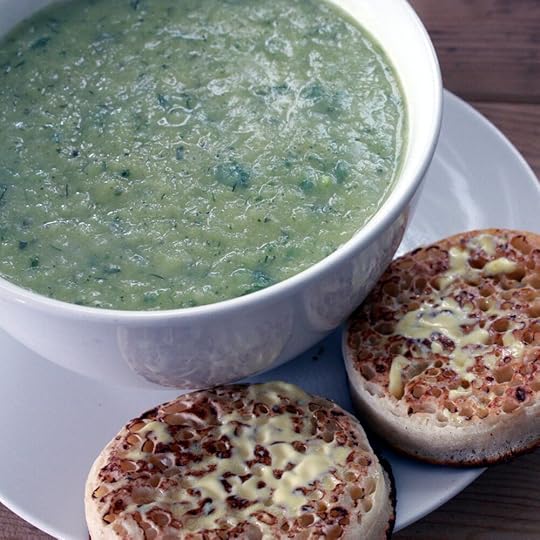
Crumpets are a surprisingly delicious soup accompaniment.
While summer might have taken its last breath, weather-wise, down here, the zucchini are still holding strong. Continuing my fierce wish to make use of everything I have, I made this delectable soup with some thick-skinned zukes that were verging on marrowhood. It was so good it made me wish zucchini season would last forever.
Zucchini and butterbean soupMakes at least 4 generous bowls
Oil and butter (sufficient to brown the vegetables, how much depends on desired richness)
1 small onion, finely chopped
1 garlic clove, finely chopped
1 small green chilli, finely chopped
650g zucchini (roughly two large ones), chopped
3 large leaves silverbeet, stems and leaves, chopped
1 x 420g can butter beans, drained
A handful of frozen peas (about half a cup, or thereabouts)
Stock of choice (vegetable, chicken or even old pesto jars rinsed out, or a combo of all three), to cover
Fresh dill, parsley, thyme and mint, a handful of each, chopped
Sea salt and freshly ground black pepper
A wedge of fresh lemon per person, to serve
Grated parmesan, to serve
I melted some butter in a saucepan for a different recipe and was so determined to use every skerrick of precious fat, that I decided I’d use the same saucepan to make the soup. To each their own. I added a splash of olive oil too.
Place the pan with oil and butter (in your desired quantity, but a tablespoon of each would be ample) on a medium-high heat and saute the onion, garlic and chilli briefly until they are starting to soften but not brown. Add the zucchini and silverbeet and cook, stirring fairly constantly, for a few minutes or until the vegetables start to soften and colour slightly.
Add the drained butter beans and frozen peas, stir to combine, then cover with the stock. I take this opportunity to rinse out any jars with only a teaspoon or so left in them (pesto is ideal for this recipe) and add that in too.
Bring the pot to the boil, then reduce to a simmer and cook for about 15 minutes until the vegetables are soft and completely cooked.
Add the fresh soft herbs, stir to combine, and cook a moment or two longer. Season to taste, then puree with a hand blender until completely smooth.
Ladle into waiting bowls, squeeze a little fresh lemon and sprinkle with a bit of grated Parmesan.
Savour, with some good bread (or crumpets) alongside.
14 comfort reads for isolation or a long weekend
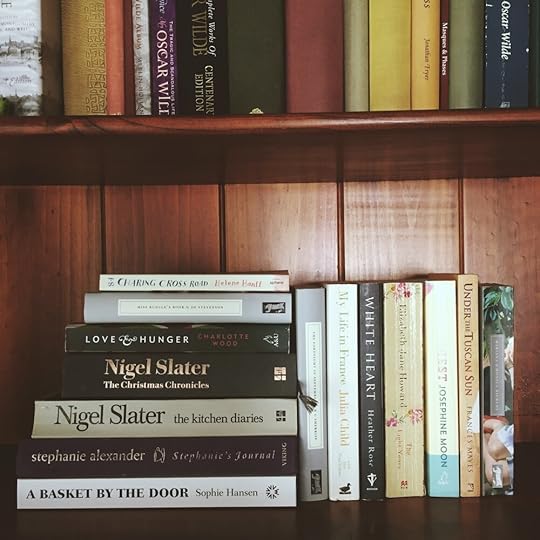
With everything that’s going on in the world, and everyone either in lockdown or being urged to stay home, I think we need the comfort and escape of reading more than ever.
Here are some of my favourite reads when I want to shut the world out for a while.
Stephanie’s Journal by Stephanie AlexanderThis is one of my favourite books (it’s one of my mate Veggie Mama’s too!) - it is the diary Stephanie Alexander kept in the year 1997, which turned out to be a momentous one for her. She closed her famous restaurant in Melbourne, opened the Richmond Hill Cafe and Larder, and held three residential cooking schools in Tuscany with her friend Maggie Beer. I have read this countless times - at least once a year since I bought it off the sale table in Fullers Bookshop in 2001 sometime. It’s just wonderful. I particularly love reading about the cooking school in the magical Tuscan countryside, and all the mouthwatering food they cooked. It’s also a retreat back to a simpler age, where Stephanie’s mention of fax machines and “the internet” are very charming indeed.
My Life in France by Julia ChildThis is one of my favourite books. It is just pure joy, from start to finish. Julia finds herself in a foreign country, not speaking the language, knowing very few people and wanting to discover her purpose in life. "At age thirty-seven, I was still discovering who I was," she writes. I feel very similarly! Her delight in discovering the pleasures of food and cooking, and her incredible work ethic and refusal to give up on a project she believed in wholeheartedly, is a balm for the soul for anyone feeling a little cynical or dejected. Never give up!
Mariana by Monica DickensThis book is a real delight. Persephone Books refer to it as a “hot water bottle novel” and that’s exactly what it is - a book you can curl up with on the sofa and escape into. Mostly set in England between the world wars, it’s the coming-of-age story of Mary, whom we follow from childhood right through to the early years of the Second World War where she is desperately waiting to hear whether her husband has survived the bombing of his ship. We see Mary’s idyllic childhood summers at her grandparents’ country home, her school days and life at home in a London flat with her widowed bohemian dressmaker mother and actor uncle, her hilarious adventures at drama school and eventually travels to Paris, and all the misguided decisions, in love and all else, she makes along the way. It is a very funny, poignant and heartwarming book all at once.
84 Charing Cross Road / The Duchess of Bloomsbury Street by Helene Hanff“I used to go to English movies just to look at the streets. I remember years ago a guy I knew told me that people going to England find exactly what they go looking for. I said I'd go looking for the England of English Literature, and he nodded and said: ‘It's there.’” Oh, this glorious book. What a treat. If you love London and books, I highly recommend it. It’s as charming and delightful as everyone says.
A Basket by The Door by Sophie HansenThis book has barely left my side since I bought it last month. Full of gorgeous photos that capture the beauty and abundance of each season in country mainland Australia, Sophie’s words and recipes are a true delight. It’s a stunning book, beautifully styled and put together. I have made so many dishes from it (a rare thing for me, despite adoring cookbooks and having perhaps a thousand of them) and everything I’ve made, from the sumptuous apple butter to the buttery wholesome oatcakes, has been sublime. As the title suggests, leaving “a basket by the door” for a friend, neighbour or family member when they might be in need of help or nourishment is a beautiful thing to do at any time, but particularly in these times, it is a wonderfully kind and thoughtful gesture. A lovely cookbook to escape into to help you make the most of the abundant autumn (fresh food-wise) we’re currently enjoying in Australia.
The Cazalet Chronicles by Elizabeth Jane Howard (five books in total, this is the first )Anyone who hasn’t read this series is in for a marvellous treat - and now would be the perfect time. I discovered the series in 2015 - I snapped up the first in the series at the local charity bookshop, and the next day I bought all the rest! The series follows the fortunes of an upper middle-class family, the Cazalets, before and after the Second World War, with five books in all. It’s utterly enthralling, like ‘Enid Blyton for grownups’ as one of my friends put it. If you want a series to get lost in, I highly recommend them.
Under The Tuscan Sun by Frances MayesThis has been a great escapist read for me since the first time I read it, borrowed from the Glenorchy library when I was about 21, desperate to travel, live abroad and see Italy with my own eyes. It’s evocative and poetic, filled with affection for Italy and food, and reading it is like sitting down for a coffee or limoncello with a friend you haven’t seen for 10 years or so but who is just the same, and you love them for it. It always makes me feel hopeful about the future, that it’s never too late to do something magical, whether it’s planting a garden or chucking it all in to buy a house in Italy.
The Tea Chest by Josephine MoonThis is a lovely curl-up-with-a-cup-of-tea read (fittingly!). The Tea Chest follows the journey of an Australian woman who moves to London to open a tea shop (like T2 or Whittard’s but with a magical element!) and the lives of various other women she encounters to help her make this dream a reality. All of the women have their own demons to battle and the story ultimately is about resilience, following your dreams and trusting yourself.
White Heart by Heather RoseThis is a book I reread every year - this is why. It’s a novel about a woman named Farley who grows up in Tasmania and who, in the face of a devastating loss (though we don’t realise exactly what this loss was until near the end), goes searching elsewhere - overseas and mainland Australia - for meaning, wholeness and love. When I first read it, aged 19, I thought it was one of the most beautifully written books I’d ever read. I still do.
The Christmas Chronicles and The Kitchen Diaries by Nigel SlaterI have said many times over the years, and almost certainly on this blog before, that Nigel Slater could write a book about paint drying and I would buy it. If you love food and find reading about it relaxing and fun, then you will be delighted with either, or both, of these two of his, which are probably my favourites of all his books. Both are written in a diary format - The Kitchen Diaries covers a whole year of eating and Christmas Chronicles covers only November to mid-January - and are magnificently evocative and poetic in true Nigel style. In Kitchen Diaries he shares what he cooks each day, making the most of what’s in season, but occasionally there’s takeaway or something simple eaten with a beer in front of the TV (reassuring!). CC is a celebration of his favourite time of year - Christmas, and winter in general. A cold Christmas is something I wholeheartedly embraced while I lived in the UK and this wonderful book made me look forward to winter for the first time in my life. As winter is approaching in Australia, I think I’ll have to read it again! Either way, if you want to escape from life for a while, Nigel is an ideal companion.
The Fortnight in September by R.C SheriffAlso one of my beloved Persephone books and one of the most accomplished, most finely observed novels I have ever read. The premise is so simple - we follow the Stevens family on their annual two week holiday to the seaside in Bognor Regis. They are a typical middle-class 1930s family and have been going to the same B&B run by the same people for a very long time. Their holiday is as well-planned and thought out as their daily lives in South London, Mr Stevens has thought of everything down to the packing of the suitcases, the timings of the trains and which beach hut to hire for the best perspective. The B&B isn’t quite as comfortable as it used to be - slightly shabby, the landlady a little older and dottier - but the Stevens family do what they’ve always done and make the best of things. It’s an absolutely fascinating novel and so finely and accurately observed. Like I said, such a simple premise but the novel manages to capture all the big concerns of life within it - love, hope, disappointment, home, family, the passing of the years. I also loved how the very feeling of being on holiday is captured in this book - how the arrival at one’s destination is so anticipated and exciting, and then the days begin to roll by faster and faster and before you know it, the holiday is over and it’s time to go back home, to normal life. Wonderful. Simply wonderful.
Miss Buncle’s Book by D.E StevensonAlso mentioned in my Persephone post and one of my favourites of theirs. Written in 1934 and hence reflecting the concerns of women at the time, without the financial security of marriage, Miss Barbara Buncle finds herself needing to supplement her already meagre income. She does what many people think will bring certain fame and fortune - write and publish a book! She writes a novel based on her village and all the people who live in it, thinking that changing names and writing it under a pseudonym will be sufficient to hide their true identities. To her huge surprise, her book (or John Smith’s book!) is a huge bestseller and her publisher wants a sequel, but lo and behold, all the villagers have read it, recognise themselves and their village immediately (which says it all, as some of it isn’t flattering!), are outraged and determined to find out who ‘John Smith’ is and make ‘him’ pay. No one suspects the dowdy and quiet Miss Buncle for a second, which is where all the hilarity ensues - but also makes an interesting observation that people often do have hidden lives and assumptions we make about others can so very often be wrong. It’s absorbing, intelligent and very charming.
Love and Hunger by Charlotte WoodFrom one of my favourite novelists, this is a wonderful collection of essays about food, cooking, sharing meals with friends and family, the psychology of eating, and how food can soothe and comfort. Wood’s observations are warm and witty, and the recipes are fantastic too (I have made Jane’s Citrus Couscous several times). Part memoir, part cookbook, this is a food lover's delight.
I hope this has given you some inspiration for delightful books to escape into and curl up with over the next little while. If you read any of them, or have any comfort reads of your own to suggest, let me know!
April 6, 2020
when the bottle breaks

Image by Steve Buissinne from Pixabay
“Everything that needs to be said has already been said. But since no one was listening, everything must be said again.” - Andre Gide
I think we are getting a very clear message from the Universe that we need to get better at living in the moment.
When I started a daily meditation practice nearly three years ago, my aim was to get better at living in the present and meeting life on its own terms. To relinquish my need for control and simply be here now in my life instead of creating an identity out of stories, whether they were past dramas and traumas, or worries about a future that hadn’t happened yet.
I can’t say I’ve mastered it. I still get lost in drama and stories every now and then. But right now, with everything the world is facing, I am grateful for my meditation practice. For the past three years, I have been training my mind to accept every thought it has, including my deepest fears, and to listen to them with mindfulness and compassion.
And yet, until the recent pandemic crisis unfolded, I was still just as guilty as the next person of putting things off until X happens or when I’m fit enough to run a half-marathon again or when I’ve had my hair cut/brows waxed or whatever feeble excuse it might have been.
I still did this, despite having learned the lesson long ago that the present moment is all we have. A lesson which current circumstances are really hammering home.
Let me tell you a story.
A few years ago now, I was living in a tiny flat in the centre of London and I had a bottle of expensive body lotion on my dressing table. It was a Christmas gift and I'd been saving it - but for what, I'm not sure. I would occasionally put a tiny daube of it on my hands when they felt dry and I wanted them to smell nice. That's what I was doing one morning as I was about to leave the house for work, just picking up the bottle to put a tiny bit on my hands and be on my way.
I must have squeezed the bottle too tightly because the next thing I knew, the bottle had broken, with jagged pieces of sharp plastic now sticking out of the thick lotion, and it had also sprayed lotion on to the floor and the wall. Just what you want when you’re running for a train, right?
Luckily, once I had wiped up the mess and got rid of the shards, I realised that if I lay the bottle on its side, with the broken side up, I could still use what was left of the lotion. But it couldn’t be "saved" any more. I would have to use it. So I did and, for the few weeks it lasted, I smelled lovely.
Why am I telling you this? you might ask. Because, like many epiphanies, it was a very small thing that held a much larger lesson.
Once my bottle was broken, that was it. I couldn't save the body lotion for another day or once we move to the new house or whatever reason I wasn't allowing myself to just use it. I had to use it now. I had to just get on with it. The choice had been taken away from me. As it has with many far more basic everyday essentials, things we used to take for granted, now.
I don't think there is nothing wrong with saving things for "best" or for a special treat. When you do indulgent things all the time, they stop becoming special and just become the norm. So I think it's important to have a balance and definitely have some things that you do save for special times to add to that sense of occasion, and truly savour them when you do.
But I'm not talking about buying a bottle of Pol Roger every weekend (though that would be amazing) and indulging in all kinds of extravagances as a distraction, although we all need those occasionally. I’m also not talking about blowing your rent money on things you don’t need or can’t afford when you need to prioritise other things right now.
What I'm talking about are the small things that you deny yourself, or put off, or only let yourself have when you’ve “earned” them, when actually those things would add so much joy and contentment to your life right now.
It could be a mug of that gorgeous, vanilla-scented loose leaf tea you love. The expensive shower gel that makes you think of ripe pears and spring flowers. New bath towels. Using the ‘good’ wine glasses, or the pretty dinner plates that your Mum gave you once a week, not just once a year.
It might not even be a thing. It could be allowing yourself to plant a garden. Get a puppy or a kitten. Learning to knit or play the piano.
Why, before everything changed, were you denying yourself these things? Why would you not have wanted to be the happiest and most fulfilled that you could possibly be? And are those reasons still valid now? It’s worth thinking about.
You never know when the choice is going to be taken away from you or when the illusion of control will be shattered. When you realise that even the ability to put something off for another time, an undefined moment in the future, was a privilege in itself.
When we save things for "later" or "for when X happens", we’re convincing ourselves that the future is going to be somehow better than what we're experiencing right now, in the present. The truth is, the future is an illusion - it doesn't exist yet. And the past is gone. All we have is now.
So don’t put off your big dreams and your tiny joyful indulgences for another day, for a far off time where you envision you might be happier, more deserving, more accomplished, more worthy.
You are worthy of your dreams and your desires in life, right now. Just as you are.
I realise that some things you want to do or treat yourself to may not be advisable or particularly do-able right now. You’re probably prioritising the basics like food and medicine and making sure your loved ones are OK over fancy hand cream, as I am.
But things won’t always be this way.
When all of this is over, I hope you will go and do all those things you’ve put off. And in the meantime, let yourself have the small moments of happiness and pleasure in your every day, whatever they might be for you. Don't wait until the bottle breaks. Or until you’re forced to stay at home.
Tell me, how are you going to look after yourself and live in the moment today?
April 5, 2020
no-waste lockdown meal plan, week 2

Glad you enjoyed my lockdown meal planning suggestions! I know it’s a scary time for a lot of us. I say let’s try and find comfort where we can and if that’s in cooking, enjoying your food and learning to make your own sourdough or yoghurt or whatever you fancy, then I say go for it. We’re all coping as best we can.
As promised, here is this week’s plan (subject to change, naturally!) and some encouragement to use this time to nourish yourself and your family, make the most of what you have already, and waste as little as possible.
Have a look at your fridge, freezer and cupboards
We have to minimise trips to the supermarket at the moment, so it makes sense to use what you have at home before venturing out to get more. Scan your fridge, pantry and freezer and see what ingredients you have already. You could even log it all in a spreadsheet and update it as you buy or use things if that’s helpful. That’s what I’m doing, but 1) that’s my project management training and 2) I kind of like taking things to the extreme!
Make a list of meals you can make
Once you know what you have in, make a list of all the meals you can think of using the ingredients you have. This is a lot of fun. You could also write down a list of all your (and partner/family’s, if you’re cooking for others too) favourite meals and see which ones you have the ingredients in for - it might be more than you think, or you could make some substitutes (grate halloumi instead of parmesan, for example).
Make a plan
Once you have your list of dishes, organise them into a week’s worth of lunches and dinners, prioritising using up the perishable items first like fresh vegetables and fruit, already-opened dairy and protein, half-empty jars of pastes/sauces in the fridge, that kind of thing.
Be adaptable and flexible
I anticipate that my meal plan might have a few switches as the week progresses. That’s cool! I think one of the best things we can be right now is flexible and roll with things, day by day.
What about breakfast?
Breakfast is probably the meal that has changed the most for me these past few weeks.
About a month ago, I stopped having a big smoothie for breakfast, which I used to do at least three times a week, if not more. I realised that, while it was a very nutritious breakfast, with the amount of fruit, almond milk, oats, peanut butter, etc I was putting in it, it was far more calorie-dense than I needed. And of course, with everything that has happened, I’m now keen to use oats, fruit, milk and other smoothie ingredients in other ways, to make them stretch further.
So our breakfasts now are pretty simple - porridge (which I make a little extra of, to make porridge bread); toast (mostly aforementioned porridge bread, with butter and Vegemite, butter and jam, ricotta and jam; or pesto and pickled tomatoes for something more substantial); or a small bowl of plain Greek yoghurt, if we want something light. I often swirl in a spoonful of homemade apple butter into the yoghurt, which is sublime.
On with the show!
Here’s this week’s plan for me and Tom. I will update with links to recipes as I make/photograph them!
Sunday 5/4
Lunch: Zucchini and butterbean soup + bread
Dinner: Roast pumpkin pizza
Monday 6/4
Lunch: Zucchini and butterbean soup + avocado toast
Dinner: Shepherd’s pie + broccoli
Tuesday 7/4
Lunch: Pumpkin and feta toasties
Dinner: Chickpea saag + rice
Wednesday 8/4
Lunch: Chickpea saag leftovers made into soup + bread
Dinner: Sweet potato and silverbeet risotto
Thursday 9/4
Lunch: Leftovers OR pickled tomato and cheese toasties
Dinner: Pasta with rich chickpea sauce (adapt this recipe)
Friday 10/4
Lunch: Frittata or zucchini slice (depends if I have any zucchini this week)
Dinner: Veggie burger, salad + chips
Saturday 11/4
Lunch: Frittata or zucchini slice (if any left) OR zucchini flatbread
Dinner: Sweet potato and silverbeet Panang curry + rice
I’m planning a lovely roast for Easter lunch on Sunday - but am not sure which nuts I have in for the traditional nut roast. That should be a fun experiment!
What about you? What’s on your meal plan this week?
April 3, 2020
lockdown meal planning
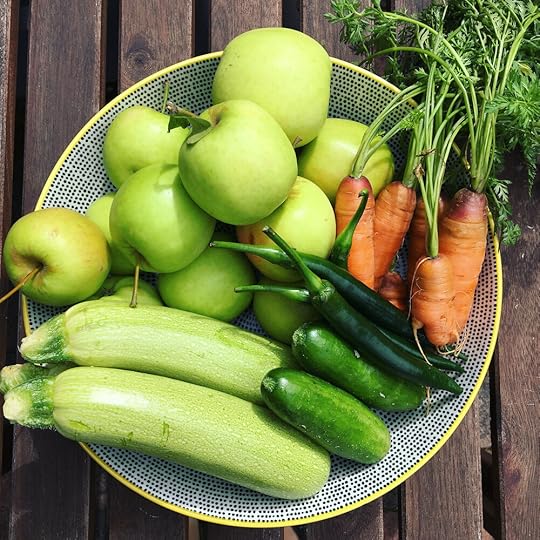
Fresh food is still plentiful. Hashtag grateful.
Life has changed a great deal for most of us over the past month.
The act of popping to the supermarket, knowing you would be able to find exactly what you need and purchase it in whatever quantity you desired, and knowing if you ran out of something you could easily replace it, feels like a long time ago.
Let’s be honest, it was a privileged and fortunate time.
We have to adapt to our new circumstances, given that the current way of things is probably how life will be for the foreseeable future.
Yet, every time I have braved the local food shop (or Woolworths or Coles), I have been comforted by the fact that there is still plenty of fresh produce available. You might not be able to get tinned tomatoes, but there are still plenty of fresh ones, as far as I can see. Friends and neighbours have been lavishing their excess produce on me, in exchange for some of what I make with it. And I’m learning to be flexible too. If I can’t get red lentils, I buy yellow split peas instead.
I don’t think we’ve had this varied and interesting a diet for some time. As a result, I’m enjoying cooking, preparing food and eating it more than ever. I can’t remember the last time I planned every meal with such care and thought, determined to make the most of what I had. It has been a welcome distraction and helped me feel focused and purposeful.
It’s also ensuring we use what we already have in, preventing any unnecessary trips to the supermarket. I was as guilty as the next person of picking up bits and pieces at least once a week, even when I had plenty already at home. Now that I plan each meal, I’m minimising waste and ensuring everything is used.
I hope this is a permanent change in my habits, whatever happens.
So, what are you cooking right now?
What other people cook, and their favourite standby pantry dinners, have always intrigued me, and never more so now. It gives me new ideas and encourages me to try different things.
So I thought I’d tell you what we’ve been eating this past week, and tomorrow I’ll post what my plan is for this coming week. Please join in!
As Tom and I are both working from home now, we’re enjoying all our meals together so I’m planning lunches as well.
I made a list of all the meals we have ingredients for and then made a plan based on what needed to be used up first (fresh vegetables, already opened dairy/tofu/pastes, leftovers). We have a small vegetable garden still producing ample silverbeet and zucchini (though I suspect the latter’s reign is coming to an end).
I am also making bread every few days. I’m not sure what we’ll do if we run out of flour! But we have plenty for now.
Phil’s No Waste Lockdown Meal Plan
Sunday 29/3
Lunch: Veggie burger
Dinner: Tomato, coconut and silverbeet dhal + rice
Monday 30/3
Lunch: Leftover dhal turned into soup + bread
Dinner: Tofu noodle stir fry
Tuesday 31/3
Lunch: Leftovers fried rice (rice from Sunday, tofu from Monday, with greens, soy sauce, chilli)
Dinner: No Waste Buddha Bowl
Wednesday 1/4
Lunch: Silverbeet, lemon and risoni soup + bread
Dinner: Zucchini slice
Thursday 2/4
Lunch: Leftover soup and zucchini slice
Dinner: Jacket potato, beans, spinach
Friday 3/4
Lunch: Zucchini slice
Dinner: Silverbeet and ricotta cannelloni
Saturday 4/4
Lunch: Haloumi and fried egg rolls
Dinner: Leftover cannelloni + green veg
I don’t know about you, but cooking has been something wonderful to focus on these past few weeks. It’s helped quieten and focus my mind. I waste nothing, I think before I use anything, and value my food in a completely different way than I used to. I hope that seeing what I’ve been up to inspires you to do the same.
April 2, 2020
no waste buddha bowl
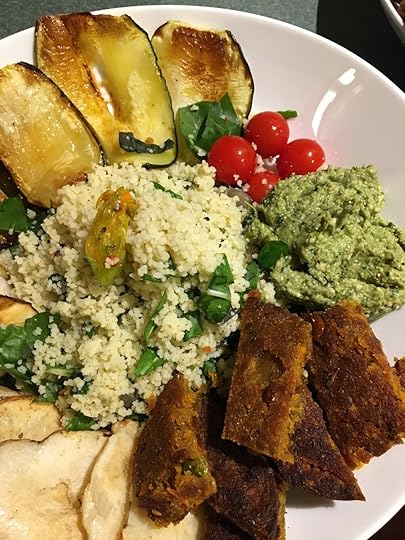
This is more of a suggestion than a recipe but I’m finding Buddha bowls like this, where you assemble a number of savoury things you have on hand or need to use up, are very useful in minimising food waste and also absolutely delicious.
Here’s how I made the one in the picture:
Grains/carb: use any leftover cooked rice, quinoa, lentils, beans, etc. I made 100g couscous (50g per person) and put in some harissa seasoning and finely chopped silverbeet leaves in with the boiling water. Left for 15 minutes with a lid on, come back and fluff it up with a fork. Yum!
Protein: Chickpeas, egg, tofu, tempeh, or whatever you’ve got on hand. I had two chickpea burgers that needed to be eaten (they had already been defrosted from a pack of 4) so they were grilled and chopped up.
Ferment: Kimchi, sauerkraut, or some kind of pickles, for interest and gut health. I used some pickled tomatoes that I made last week, which are sensational. I got the recipe from Elly Curshen’s Green. This is what I plan to do with all cherry tomatoes that enter my house from now on.
Vegetables: Whatever fresh vegetables you have to use up, throw them in. And get creative! You can leave them raw or find an interesting way to cook them. I had a zucchini (of course! Plus flowers) and two small potatoes. I cut the zucchini into thick slices and the potatoes into thin slices, and roasted them all together with cooking spray and some flavoured salt. OMG. Not all the slices made it into the bowls, let’s put it that way!
Fresh herbs: if you have any to hand. Basil, thyme, dill, parsley, coriander - any of the soft herbs work well here. Avoid anything like sage and rosemary, unless you’re going to cook them with the vegetables.
Dip/sauce/dressing: Pesto, hummus, tzatziki, tahini, mashed avocado….whatever you have or like. My friend very kindly shared some kale, walnut and basil pesto she made and dropped it on our doorstep, so I was keen to use that.
Finally: I squeezed a lemon wedge over each bowl and ground some pepper over the top. There might have been a bit of pickled chilli put on my bowl too.
Mindful, conscious, no-waste eating never tasted so good!
spiced zucchini and apple loaf

Might not look like much - but it’s good!
I’m making the most of my zucchini glut, as I’m sure you’ve been able to tell!
I’m trying to ration my eggs and butter carefully at the moment, so I decided to make this cake vegan and see what the results were. And it was spectacular.
It’s a supremely moist cake anyway, thanks to the zucchini, but with the apple sauce involved too, the outside of the loaf is crusty and the middle is almost custardy. So it’s perfect for dessert as well as alongside your morning or afternoon cup of coffee.
And don’t skimp on the spices - it may seem like a lot but the whole point is that the flavour of the spices is very pronounced in this cake. If you prefer the flavours to be subtler, halve the quantities I’ve listed below. You can use any combination of baking spices you like (mixed spice, ground nutmeg, etc) but what I’ve listed below was a particularly good combination, for a spice lover like me. I’d never put black pepper in a cake before and was amazed by how just three turns of the pepper grinder gave it such a pleasant heat.
I hope you give it a try!
Spiced zucchini and apple loafInspired by a similar recipe in A Basket By the Door by Sophie Hansen
Roughly 500g grated zucchini (courgette), about 3 large ones (you can even use marrow, just cut the woolly middle bit out first)
250g wholemeal plain flour or wholemeal spelt flour
2 teaspoons baking powder
2 teaspoons ground cinnamon
2 teaspoons ground ginger
1 teaspoon ground cloves
A generous grating of fresh nutmeg
3 turns of the black pepper grinder
A pinch of salt
1 teaspoon vanilla extract
200g brown sugar
6 heaped tablespoons apple sauce or puree
100ml olive oil
Preheat the oven to 180 C (fan-forced). Grease and line a large loaf tin or two small ones.
Squeeze as much liquid out of the grated zucchini as you can.
Place the squeezed grated zucchini in a bowl and add the flour, spices and salt, stir to combine. Add the vanilla, brown sugar, apple sauce and oil, and stir together until well combined (though try not to overmix, naturally).
Pour the batter into your prepared tin or tins, and bake in the oven for 1 hour or until a skewer inserted into the centre comes out clean. My oven is hotter than most so I checked mine after 45 minutes.
Allow the loaf to cool slightly then remove from the tin on to a cake rack to cool completely.
As it makes a large loaf, or two small ones, you can also happily freeze it in slices to defrost in the toaster whenever you need some comforting home-baked goodness. Which, let’s face it, in the times of coronavirus, is pretty much every day!
Enjoy it fresh or toasted, spread with butter, ricotta or left plain, and absolutely with a steaming cup of tea or coffee alongside.
tomato, coconut and silverbeet dhal
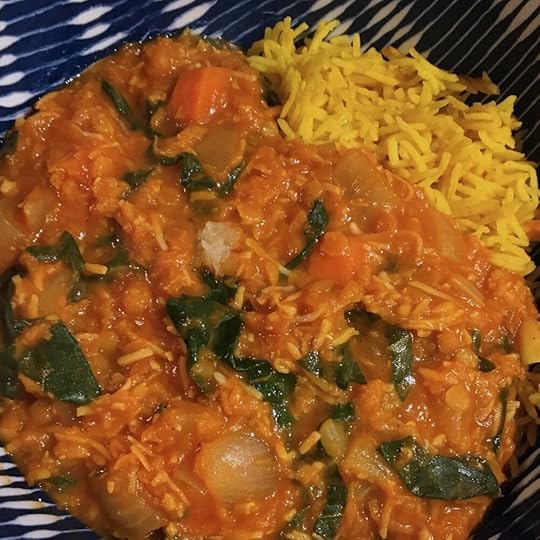
Sorry, it’s not the best picture. This is why I should cook dinner while it’s still light outside.
I have made many a dhal in my time and I am not exaggerating when I say this is one of the best I’ve ever made. It’s comforting, spicy, delicious and filling - everything I want in a home-cooked meal.
If you have a bag of lentils that’s been waiting in your pantry for its moment in the sun, this is the dish! Red lentils are my preferred lentil but as they are harder and harder to come by at the supermarkets at the moment, you can use yellow split peas, green lentils, brown lentils, or indeed, any lentil you can find. Red break down faster and tend to transform into the delectable creaminess that you want for the comfort factor in a dhal, but regardless of what kind of lentils you use, it will still be delicious.
I cooked my rice with a little turmeric, cinnamon and a star anise and I will be making rice this way to serve with dhals and curries from now on - it was spectacular. Just a shake of each spice, whack in the star anise and make your rice in the usual way. As Jamie Oliver would say, happy days.
Tomato, coconut and silverbeet dhalServes 4
1 tablespoon coconut oil
1 large onion, finely chopped
2 garlic cloves, finely chopped
1 large carrot, finely chopped
4 large leaves silverbeet, stalks and leaves, finely chopped (use spinach, chard, spring greens, whatever greens you have)
1 tablespoon turmeric
1 tablespoon ground cumin
1 tablespoon curry powder or garam masala
2 teaspoons Kashmiri chilli powder (or other hot chilli powder)
200g red lentils
2-4 tablespoons tomato paste (depending on the other tomato components you have)
400g tomato passatta or chopped tomatoes
Whatever other fresh tomatoes you have that need using up, chopped
Boiling water, to cover
1 cup shredded coconut (more if you like it extra coconutty)
Salt, to taste
Lemon juice, to taste
Basmati rice, cooked as detailed above, to serve
Yoghurt, to serve (optional)
In a large stockpot, melt the coconut oil then saute the onion, garlic, carrot (plus any other vegetables you want to use up) and silverbeet stalks (reserve the leaves for later) until starting to soften. Add the spices, and a little water, and allow to cook and release the aromas for a minute or two. Don’t let the spices burn, add water if it’s getting a bit dry.
Add lentils, tomato paste and tomatoes, stir to combine, then cover the lot with boiling water from the kettle. You want it to be very soupy, remembering that the lentils will absorb some of the liquid as they cook. Bring to the boil, then reduce the heat, put a lid on and simmer for 15 minutes, stirring occasionally, then add the shredded coconut, stir in well, then replace the lid and continue to cook for another 5-10 minutes, or until the lentils are soft. Add the silverbeet leaves, stir and cover again for 2 minutes or until the silverbeet is wilted. Add salt and lemon juice to your taste.
Serve with rice, a dollop of yoghurt and pride. You made this wholesome, delicious meal for yourself! You’re awesome.
zucchini flatbread
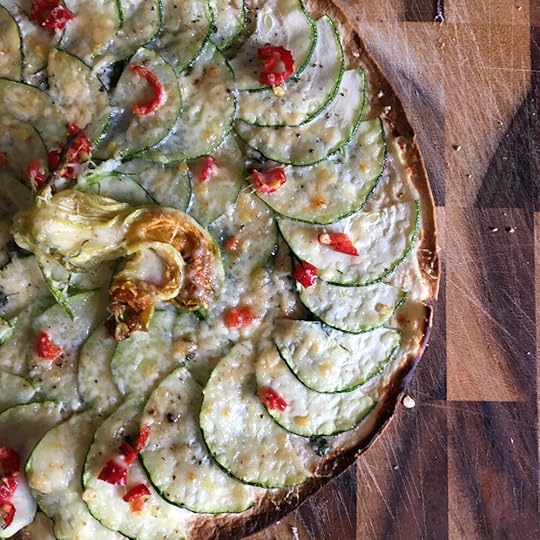
In a bid to waste nothing and make the most of my zucchini bounty, I came up with this dish at the weekend, faced with a lone multigrain wrap and a zucchini I had accidentally mandolined rather than grated in the food processor (I’d put the blade on the wrong way!).
It was so delicious! Tom and I shared this one but I will definitely make us one each next time. The recipe is easily doubled, tripled or quadrupled depending on how many flatbreads you have to use.
Zucchini flatbreadMakes one, for two to (reluctantly) share
1 medium zucchini, thinly sliced or mandolined
1 wrap or large pitta bread
2-3 tablespoons ricotta, pesto, cottage cheese or thick Greek yoghurt (I used ricotta)
1 small red chilli, finely chopped or a pinch of dried chilli flakes
A handful of fresh thyme leaves
A handful of grated cheese of your choice (I used ready-grated Parmesan)
Spread the ricotta across the base of the wrap. Layer the zucchini slices on top in concentric circles. Scatter with thyme, chilli and cheese. If you have a zucchini flower from the garden, put that in the middle too for that cheffy touch. Grind some black pepper over the top, if you like.

Prior to going into the oven! I thought it looked rather beautiful.
Bake for 5-8 minutes in a hot oven (check after 5, depending on the thickness of the wrap or pitta bread) until golden and bubbling. Allow to cool slightly, then cut into wedges as you would a pizza, and devour.
April 1, 2020
apricot and date chutney
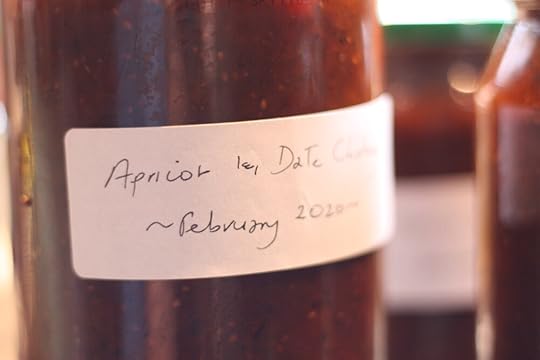
In February, my aunt very kindly gave me some apricots off her tree. When I say “some”, I mean 12 kilograms of them. Fortunately, Tasmanian apricots are incredible - like the sort of apricots you’d get in France - so I was not stumped on ideas of what to do with them. If anything, I had too many options!
I opted for stewing some, making jam, experimenting with mustard (which went terribly wrong, the jars exploded when we experienced summer’s last desperate attempt at heat) and turning the rest into delectable chutneys. Word has spread about these chutneys and they are now, after two months’ maturation in my pantry, a valuable currency to barter with in these strange times. I’ve swapped jars of it for fresh tomatoes, rhubarb, apples, cucumbers, pesto and even a new heater!
On chutney making day, apparently the whole street smelled of this delightful apricot and date concoction. Tom told me, as he turned the corner on to our street on his walk home from work, he followed the scent all the way back to our house! Chutney is a delightful thing for your home to smell of.
Be warned - this is not something you’ll be able to rustle up in a hurry. This is a labour of love and you will be exhausted by the end of it. It takes time, as all worthwhile things do, but you’ll be rewarded greatly for your efforts.
Apricot and date chutneyMakes heaps, at least 12 jars
3.5 kilograms fresh ripe apricots, halved and kernels discarded
900g brown sugar
900g pitted dates, halved (you could use sultanas if you prefer)
6 large onions, finely chopped
85g sea salt
1 litre vinegar (any kind - I used plain white vinegar from Woolworths!)
1 tablespoon ground cloves
2 tablespoons mustard powder or brown mustard seeds (I went with seeds for this batch)
2 tablespoons ground ginger
1 teaspoon cayenne pepper
2 teaspoons harissa powder or chilli powder (optional - I like everything to have a kick!)
Place everything in a giant preserving pan (I inherited my grandmother’s) or a large stockpot. Bring to a slow boil, and then reduce to a simmer and cook until thick and the fruit has broken down. Thanks to the dates, it will be a rich brown colour.
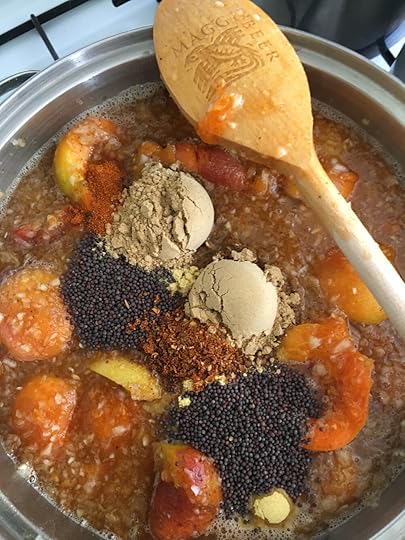
In progress!
The original recipe my aunt gave me said to cook for 45 minutes - I found I cooked mine for the best part of 3 hours until enough vinegar had evaporated and it was sufficiently thick. But my stove is a relic that belongs either in the tip or a museum, so you may well have a more modern and reliable stove that cooks the chutney faster! Either way, keep an eye on it, stir regularly to prevent it burning or sticking to the bottom, and go with your instincts. I’ve made a lot of chutney in my time, so I know when one is ready. It all comes with practice.
Have your jars sterilised and ready to go. I don’t have a dishwasher so I washed mine in hot soapy water then dried them in a low oven. This is quite intensive, but as I said at the start, this is not something you’ll do in half an hour, it’s very much a labour of love so you need to embrace the slow and enjoy the process.
Carefully pour the hot chutney into the hot jars. A funnel is ideal, if you have one big enough.
Seal immediately. Label when cool and then store the jars in a dark, cool place to mature. I opened the first jar after a month and it’s already excellent. The longer you leave it, the better it will be. You can keep them unopened in the pantry for up to a year, provided you’ve sterilised everything properly, but once you open a jar, keep it in the fridge.
This chutney has thousands of uses. I love it with cheese on toast, dolloped on dhal or another Indian curry, as an alternative to tomato ketchup for dipping chips in, with a veggie burger, or on the side of a giant wodge of zucchini slice.
Philippa Moore's Blog
- Philippa Moore's profile
- 7 followers



